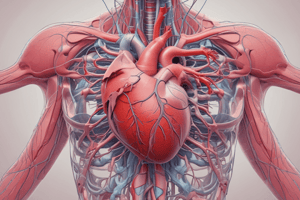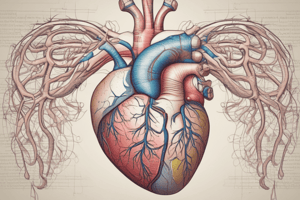Podcast
Questions and Answers
Which valves have chordae tendineae? (Select all that apply)
Which valves have chordae tendineae? (Select all that apply)
- Aortic and pulmonary valves
- Bicuspid (mitral) and tricuspid valves (correct)
- Coronary valves
- Valves in veins
- Semilunar valves
Capillaries are?
Capillaries are?
- Thick walled vessels that carry blood away from the heart
- Microscopic vessels in which blood exchanges material with the interstitial fluid (correct)
- Thin walled vessels that carry blood deficient in oxygen
- Thin walled vessels that carry blood toward the heart
- Thick walled vessels that carry blood rich in oxygen
As blood flows away from the heart, how does overall blood pressure in vessels change? Why?
As blood flows away from the heart, how does overall blood pressure in vessels change? Why?
- Blood pressure increases. Otherwise, the blood would not flow up toward the heart.
- Blood pressure increases, because vessel diameter narrows with distance from the heart, which increases the force on the blood.
- Blood pressure decreases, because blood vessels are passive and cannot exert force on the moving blood.
- Blood pressure decreases, because of the effects of friction between the vessel walls and the moving blood. (correct)
Which statement about hydrostatic pressure is FALSE?
Which statement about hydrostatic pressure is FALSE?
A patient is given a beta 1 agonist. What would you expect to find?
A patient is given a beta 1 agonist. What would you expect to find?
Place these structures in the order that blood returning to the heart from the body would pass through them:
Place these structures in the order that blood returning to the heart from the body would pass through them:
The sac around the heart is the?
The sac around the heart is the?
Why does the pressure in the arteries and arterioles fall as the blood moves away from the heart?
Why does the pressure in the arteries and arterioles fall as the blood moves away from the heart?
As blood vessel length increases?
As blood vessel length increases?
If blood pressure doubles at the same time that the peripheral resistance doubles, the blood flow through a vessel would be?
If blood pressure doubles at the same time that the peripheral resistance doubles, the blood flow through a vessel would be?
Which of the following causes a decrease in resistance in a vessel?
Which of the following causes a decrease in resistance in a vessel?
Which blood vessels have the lowest blood pressure?
Which blood vessels have the lowest blood pressure?
The purpose of valves in the cardiovascular system is to?
The purpose of valves in the cardiovascular system is to?
The driving force for blood flow is a(n) ________ gradient.
The driving force for blood flow is a(n) ________ gradient.
Match the change with the cardiovascular event described: The blood pressure in a vessel is 10 units at point A and 10 units at point B. Flow between those points is?
Match the change with the cardiovascular event described: The blood pressure in a vessel is 10 units at point A and 10 units at point B. Flow between those points is?
The first branch off the aorta represents which blood vessel(s)?
The first branch off the aorta represents which blood vessel(s)?
The function of the pericardial fluid is to?
The function of the pericardial fluid is to?
Which organ is NOT known to include a portal system for blood?
Which organ is NOT known to include a portal system for blood?
The action potential in a cardiac contractile cell causes?
The action potential in a cardiac contractile cell causes?
Which of the following is the best definition of an artery?
Which of the following is the best definition of an artery?
Flashcards
Chordae tendineae
Chordae tendineae
Strong, fibrous cords attaching the heart valves to the papillary muscles, preventing valve inversion during ventricular contraction.
Capillaries
Capillaries
Microscopic blood vessels where material exchange with interstitial fluid occurs.
Blood pressure decrease w/distance
Blood pressure decrease w/distance
Blood pressure falls as blood moves away from the heart due to friction between blood and vessel walls.
Hydrostatic pressure
Hydrostatic pressure
Signup and view all the flashcards
Beta 1 agonist effect
Beta 1 agonist effect
Signup and view all the flashcards
Blood flow order
Blood flow order
Signup and view all the flashcards
Pericardium
Pericardium
Signup and view all the flashcards
Blood pressure drop in arteries
Blood pressure drop in arteries
Signup and view all the flashcards
Resistance & Blood flow relationship
Resistance & Blood flow relationship
Signup and view all the flashcards
Resistance decreases by
Resistance decreases by
Signup and view all the flashcards
Study Notes
Blood Vessel Valves and Chordae Tendineae
- Bicuspid (mitral) and tricuspid valves have chordae tendineae
- Semilunar valves (aortic and pulmonary) do not
Capillary Function
- Thin-walled vessels
- Allow exchange of material with interstitial fluid
Blood Pressure Changes
- Blood pressure decreases as distance from the heart increases, due to friction
- Blood pressure does not flow upwards on its own; otherwise, blood would pool and not move
- Hydrostatic pressure is the pressure exerted by a fluid at rest.
- Dynamic pressure is the pressure exerted by a fluid in motion
Beta 1 Agonist Effects
- Increases heart rate and cardiac output
Blood Flow Order
- Structures blood flows through returning to heart: Right atrium, Right ventricle, Pulmonary arteries, Pulmonary veins, Left atrium, Left ventricle
Heart Sac
- The pericardium is the sac surrounding the heart
Arterial Pressure Drop
- Friction causes a loss of energy
- Arteries and arterioles get smaller further from the heart
Resistance and Flow
- Resistance increases as blood vessel length increases
- Flow decreases as resistance increases
Blood Pressure and Resistance
- If both blood pressure and peripheral resistance double, blood flow remains unchanged.
- Increase flow: (Increased radius)
- Decrease flow: (Increased length, Increased viscosity, Decreased radius)
Blood Vessel Lowest Pressure
- Capillaries have the lowest blood pressure
Valve Function
- Valves prevent backflow of blood
Studying That Suits You
Use AI to generate personalized quizzes and flashcards to suit your learning preferences.
Related Documents
Description
Explore the intricate structures and functions of the cardiovascular system, including heart valves, blood vessel characteristics, and blood flow dynamics. This quiz covers essential topics such as blood pressure changes and the effects of beta-1 agonists on heart performance.




